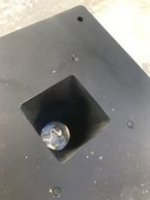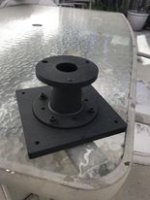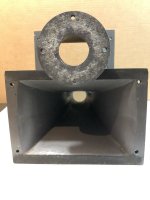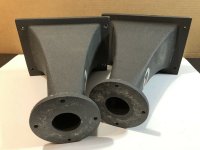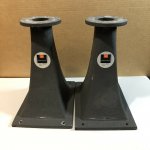Hi, folks, I have access to a nice CNC machine and would like to make a small tweeter tractrix horn for my TAD 2001 driver. I intend to cross it over at 5K so the horn can be really small, like 2.5-3KHz or even smaller. Has anybody made a horn like this and would you share your experience and maybe plans? Thanks.
I did not make a tractrix horn (used different profile), but it is easy to make one. Generate your profile in Hornresp, import into the 3D soft of your choice, rotate, add thickness, flange and that is it.
why would you CNC the horn instead of 3D printing it ?Hi, folks, I have access to a nice CNC machine and would like to make a small tweeter tractrix horn for my TAD 2001 driver. I intend to cross it over at 5K so the horn can be really small, like 2.5-3KHz or even smaller. Has anybody made a horn like this and would you share your experience and maybe plans? Thanks.
I forgot to mention - this horn is quite nice: https://josephcrowe.com/collections/speaker-plans/products/3d-print-your-own-es-1700-circular-horn - and Mr. Crowe can modify it or create a custom design for you. The ES curvature would be superior to Tractrix IMHO. I printed some ES horns and they work pretty well.
Well, the reason is simple: I have access to a CNC machine and a person who knows how to write G-files and I have no access to a 3D printer. But, of course, you're right: D-printing a small horn is very elegant and way less messy than machining it out of a solid piece of aluminum. And, probably, faster as well - yesterday I spent a good part of my weekend machining two horn adapters for a 2" driver to mate with a 2"x2" horn throat.why would you CNC the horn instead of 3D printing it ?
we should have like a library of throat adapter files that can be readily CNC / 3D PrintedWell, the reason is simple: I have access to a CNC machine and a person who knows how to write G-files and I have no access to a 3D printer. But, of course, you're right: D-printing a small horn is very elegant and way less messy than machining it out of a solid piece of aluminum. And, probably, faster as well - yesterday I spent a good part of my weekend machining two horn adapters for a 2" driver to mate with a 2"x2" horn throat.
i am also considering designing a 3D printed adapter from 2" throat to rectangular entry plywood horn but these things should simply be in some database.
there are somewhat similar adapters on eBay made of cast aluminum from vintage horns that were made in two parts ( an aluminum part plus fiberglass part or something like that ) but can't rely on endless supply of original parts from 50 year old speakers ...
Joseph's work is amazing.I forgot to mention - this horn is quite nice: https://josephcrowe.com/collections/speaker-plans/products/3d-print-your-own-es-1700-circular-horn - and Mr. Crowe can modify it or create a custom design for you. The ES curvature would be superior to Tractrix IMHO. I printed some ES horns and they work pretty well.
we should have like a library of throat adapter files that can be readily CNC / 3D Printed
i am also considering designing a 3D printed adapter from 2" throat to rectangular entry plywood horn but these things should simply be in some database.
there are somewhat similar adapters on eBay made of cast aluminum from vintage horns that were made in two parts ( an aluminum part plus fiberglass part or something like that ) but can't rely on endless supply of original parts from 50 year old speakers ...
These are the ones I made yesterday. Yes, your idea is great. But those cast aluminum adapters don't allow you to mate round throat drivers with rectangular horns. BTW, CAD program we're using has round-to-square adapters data base. You just need to enter diameter, square size and the depth of the path. What I've done with good results was bolting down a plate of solid aluminum to an Ebay available horn adapter and then machining a smooth round-to-square transition on the CNC machine.
Attachments
Last edited:
i meant like this ...These are the ones I made yesterday. Yes, your idea is great. But those cast aluminum adapters don't allow you to mate round throat drivers with rectangular horns. BTW, CAD program we're using has round-to-square adapters data base. You just need to enter diameter, square size and the depth of the path. What I've done with good results was bolting down a plate of solid aluminum to a bay available horn adapter and then machining a smooth round-to-square transition on the CNC machine.
these were some of the fist to show up on eBay when i searched "rectangular horn adapter jbl vintage"
but these are going for $600 for example so that's kind of an issue LOL
but if i had one of these and the hole / bolt pattern matched the driver i could complete the horn mouth in plywood ...
these are more or less what i would have to 3D print ...
Attachments
And here is the rest of the story - as it turns out, TAD 2001 flare rate without any horn is just about 2500 Hz so horn is really unnecessary if you use it as a tweeter and the crossover point is set at 5000Hz. I will attach something decorative to the TAD's mouth but just to make the whole thing pretty.
I made a set from Papier-Maché. A lower cutoff, but they weren't very big. They sounded very, very nice.
could you post a pic?I made a set from Papier-Maché. A lower cutoff, but they weren't very big. They sounded very, very nice.
I don't think I ever took one. 🙁 I used a 100% cotton water color paper, very heavy. We had a lot of scraps at work.
The horns were maybe 8 or 9 petal Tractrix done with the tractrix calculator . The sound was so surprisingly clean and neutral. Inexpensive, but labor intensive.
The horns were maybe 8 or 9 petal Tractrix done with the tractrix calculator . The sound was so surprisingly clean and neutral. Inexpensive, but labor intensive.
- Home
- Design & Build
- Construction Tips
- 2500-3000Hz tractrix horn
